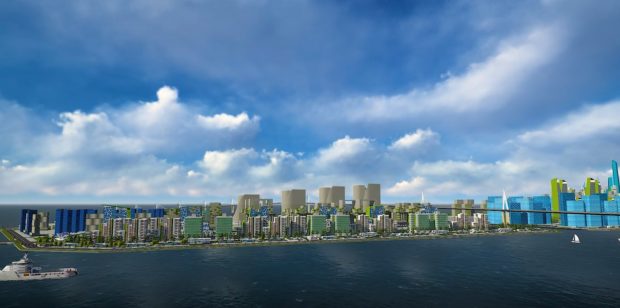Manila Mayor Joseph “Erap” Estrada has approved another multi-billion-peso reclamation project in Manila Bay – a 318-hectare commercial and tourism hub along the shorelines of Roxas Boulevard.
Called the “Manila Waterfront City”, this mixed-use development project is the fourth big-ticket reclamation venture approved under the Estrada administration in less than two years’ time.
“Reclamation projects are the cornerstone of our urban renewal program,” Estrada said during the signing of a Memorandum of Understanding (MOU) with Philippine Reclamation Authority (PRA) Chairman of the Board Alberto Agra, General Manager Janilo Rubiato and Waterfront Manila Premier Development Inc. (WMPD) President Kenneth Gatchalian at the City Hall.
“They translate to more lands, better infrastructure, more businesses and more jobs, increased revenues, and better opportunities for all,” Estrada pointed out.
The signed MOU virtually seals the deal for the construction of the new mixed-use development center at another portion of Manila Bay which proponents described will respect the “historic content and character” of the city of Manila.
The soon-to-be constructed island will host commercial centers and residential buildings, high-class hotels, and entertainment facilities and gaming venues such as casinos, according to Gatchalian.
It will also house amusement parks, medical centers, government offices, schools, and other establishments such as art museums and exhibits, aside from sports facilities and amenities for aquatic sports such as rowing and sailing.
The man-made island will also have a port for international cruise ships.
“The inspiration here is basically expanding what the city of Manila has right now which is its historic character… the concept is basically extending Luneta (Rizal Park) and sticking to the historic content of Manila which in itself is what it is known for,” Gatchalian said in an interview.
Self-sustaining environment
What sets the Manila Waterfront City apart from the other reclamation projects in Manila Bay, Gatchalian pointed out, is its adequate open space “where we give the parks back to the city and the people.”
“It’s a self-sustaining environment but we will not clutter it with concrete infrastructures,” he added.
The project is deliberately planned to be environment conscious by preserving the few remaining “greens” of Manila and engulfing the expanse with hectares of open and green spaces, making this modern development a “breathable city”, added WMPD chairman Sergio Ortiz-Luis Jr.
“As a compliment to the now already magnificent Manila Bay waterfront, we made sure that this new development will be an added enhancement – breathing new life to the old bayfront while evolving as a complementing attraction to its magnificence,” Luis said.
With the MOU signing, Gatchalian said they need at least a year-and-a-half to prepare and finish the documentation before initial reclamation works commence.
“By 2020 there’ll be huge physical movement, right now we’re at the documentation stage,” he said.
Rubiato explained that the WMPD, through its joint venture agreement (JVA) with the City of Manila, will have to submit within a period of 18 months the mandatory requirements such as feasibility study, geo-hazard studies, detailed engineering designs and most importantly, an environmental compliance certificate (ECC) from the Department of Environment and Natural Resources (DENR).
PRA, as the central regulatory body for reclamation projects, will evaluate those requirements to determine the “soundness and viability” of the project,” Rubiato said.
The Manila Waterfront City reclamation project is the fourth JVA entered into by the Estrada administration in less than two years’ time.
Only last June, Estrada signed another MOU with PRA and real estate firm J-Bros Construction Corp. for the construction of a P100-billion, 419-hectare commercial district in another portion of Manila Bay.
The “Horizon Manila”, touted to be the biggest reclamation project in Manila Bay so far, involves the construction of three islands between the Manila-Pasay border in the south and Roxas Boulevard in the east, stretching to about 3.5 kilometers of the shores of Manila Bay.
2 other projects
The Horizon Manila and Manila Waterfront City are on top of two other reclamation projects approved by PRA during Estrada’s time.
The two others are the UAA Kinming Group Development Corp.’s “New Manila Bay International Community” (407.42 hectares) and the P7.4-billion expansion of the Manila Harbour Centre in Tondo by the construction firm R-II Builders, Inc.
Another multi-billion-peso reclamation project, which has long been in the drawing board before Estrada’s time, is set to begin construction in Manila Bay – the 148-hectare “Solar City” urban center.
Last January, the city council of Manila finally ratified the consortium agreement and the Joint Venture Agreement (JVA) signed by the city government and Solar City proponent Manila Goldcoast Development Corp. (MGDC) on April 7, 2012 and June 7, 2012, respectively.
Solar City is a 148-hectare, state-of-the-art, tourism, commercial and residential district that will be put up in Manila Bay to host business centers, residential and commercial properties, and tourism facilities, including an international cruise ship terminal.
